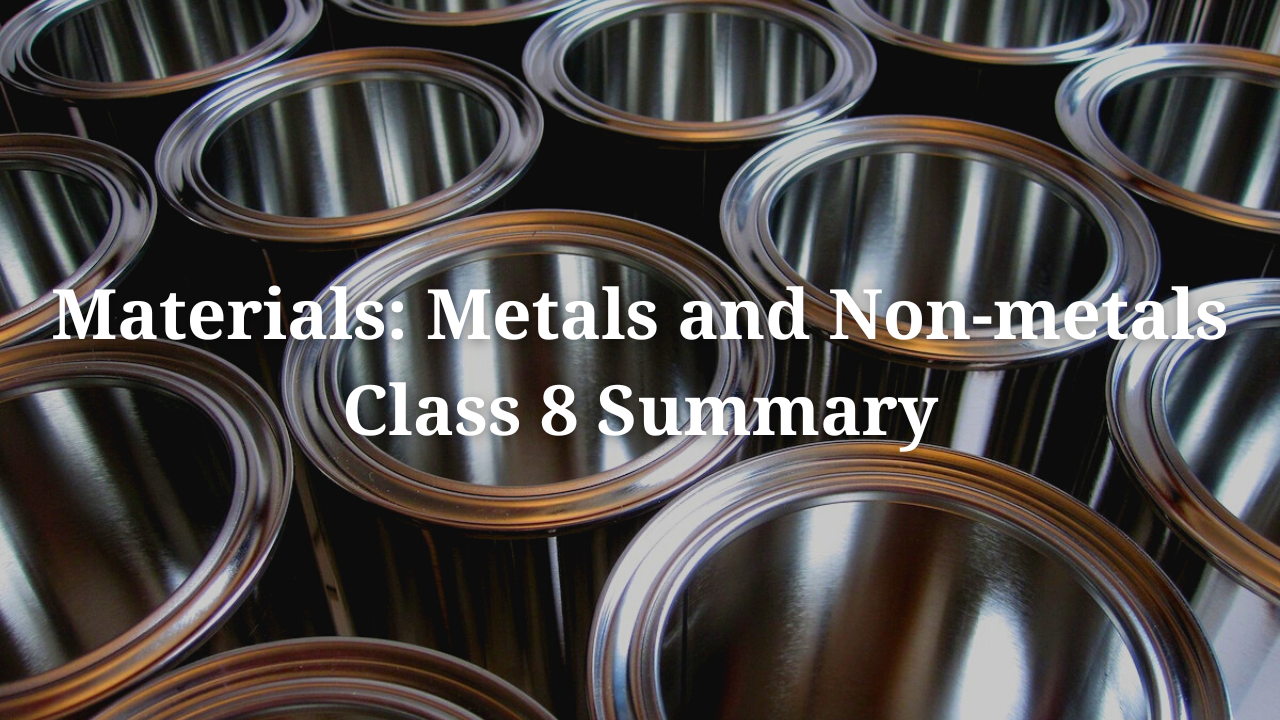Introduction:
Each thing around us was categorized as metal or nonmetal. Hence, it is necessary to notice metals, and non-metals, and how to transform them. In this lesson, we will learn the several physical and chemical properties of metals and non-metals.
Notes for Chapter 4 Materials: Metals and Non-metals Class 8 NCERT
Physical Properties of Metals:
Metals are materials that were
- hard
- malleable
- sonorous
- lustrous
- good conductors of electricity and heat
And also similar to potassium and sodium were soft and also can be cut with the help of a knife. Mercury is the only metal that is found in a liquid state.
Examples of Metals are:
- Aluminum
- Magnesium
- Iron
- Copper
- Calcium
- Gold, etc
Physical Properties of Non-metals:
- They are low-paid conductors of heat and electricity.
- Take place as liquids, solids, and gases at place temperature.
- Non-metals are soft (For example coal )
- They are Non-sonorous
- They are Non-malleable
- They are Non-ductile
- Brittle ( the metal which breaks in the hammer )
Examples of Non-Metals are:
- Chlorine
- Nitrogen
- Phosphorus
- Hydrogen
- Fluorine
- Carbon
- Selenium
Chemical Properties of Metals and Non-metals:
Reaction Metal with Water:
The metals will form metal hydroxides and hydrogen gas when it reacts with water.
Metal +Water →Metal hydroxide or Metal Oxide +Hydrogen
i) Sodium is the high reactive metal sodium will react vigorously with cold water.
2Na+2H2O(cold)→2NaOH+H2+heat
ii) Magnesium is the least reactive metal therefore it will react slowly with cold water but it will react vigorously with hot water.
Mg+2H2O(hot)→Mg(OH)2+H2
iii) Metals such as zinc and iron were less reactive even with the stream water.
Zn+H2O(steam)→ZnO+H2
Reaction of Non-Metal with water :
Non- Metal + Water →No Reaction
Reaction with oxygen:
Metal Reaction with oxygen:
Both Metals and Non -Metals react with oxygen to form oxides.
Metal + Oxygen = Metal Oxide
Non- Metal + Oxygen = Non-Metal Oxide
Example for Metal: Magnesium + Oxygen = Magnesium Oxide
Example for Non Metal: Sulphur + Oxygen = Sulphur dioxide
Also Learn:
Reaction with Bases:
To produce the Hydrogen gas Metal will react to the bases.
For Example: AI +NaOH→ NaAIO2 + H2
To produce the salt Non-metal will react to the bases.
For Example: Cl2+2NaOH→NaCl+NaOCl+H2O
Reactivity Series:
Metals from high order to low order.
| Symbol | Element |
| K | Potassium |
| Ba | Barium |
| Ca | Calcium |
| Na | Sodium |
| Mg | Magnesium |
| Al | Aluminum |
| Zn | Zinc |
| Fe | Iron |
| Ni | Nickel |
| Sn | Tin |
| Pb | Lead |
| H | Hydrogen |
| Cu | Copper |
| Hg | Mercury |
| Ag | Silver |
| Au | Gold |
| Pt | Platinum |
Definitions:
Luster:
The property of the metal by it shines.
Hardness:
The property of the materials which makes it hard.
Malleability:
The property of the materials which can be beaten into sheets.
Ductility:
The property of the materials which can be drawn into wires.
Sonority:
The property of the materials which produces a ringing sound when struck with a hard object.
Conduction of electricity:
The property of the materials which allow the electricity to pass through it.
Conduction of heat:
The property of the materials which allows it to transfer heat.
DOWNLOAD the PDF here
